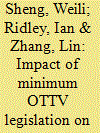| Srl | Item |
| 1 |
ID:
169835


|
|
|
|
|
| Summary/Abstract |
As a measure of building envelope performance, Overall Thermal Transfer Value (OTTV) has been regulated in many countries and regions in the world, while little research is done to evaluate its city-scale effect with energy consumption. In this paper, we develop an econometric energy epidemiology model to evaluate the impact of OTTV legislations on electricity consumption using Hong Kong as an example, as Hong Kong government is one of the first adopters of OTTV regulation. For this purpose, we construct a unique database on the energy consumption of residential and commercial buildings in Hong Kong, including 39092 buildings from 1982 to 2016. Noticeable contributions to the total building energy saving could be found from historical OTTV legislations by 2016. As predicted by the model, in 2030, the annual electricity reduction can reach approximately 20000TJ without further regulation amendment, which is an important support to the “HK3030” energy target.
|
|
|
|
|
|
|
|
|
|
|
|
|
|
|
|
| 2 |
ID:
092837


|
|
|
|
|
| Publication |
2009.
|
| Summary/Abstract |
China's building sector consumes one quarter of total energy consumption in the country and plays an important role in long-term ability of the country to achieve sustainable development. This paper discusses a comprehensive approach to achieving low carbon sustainability in large commercial buildings in China incorporating both energy and carbon-reduction strategies. The approach concentrates primarily on three complementary aspects: (a) the introduction of an effective energy management system; (b) the incorporation of relevant advanced energy saving technologies and measures and (c) the promotion of awareness among occupants to make changes in their behaviour towards a more environmental-friendly behaviour. However, reference is also made to the role that renewable energy and offsetting may have in the effective management and environmental performance of buildings.
Nine examples of large commercial buildings in Beijing and Shanghai were studied and the average electricity consumption of around 153 kWh/m2 per annum is about 5 times higher than average electricity use in residential buildings. At the same time the associated green house gas (GHG) emissions are around 158 kg/m2 per annum.
|
|
|
|
|
|
|
|
|
|
|
|
|
|
|
|